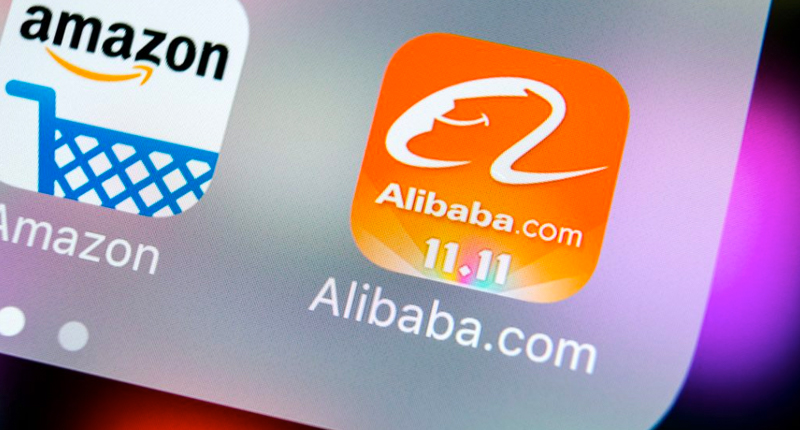By 2030, will Alibaba be worth more than Amazon?
- Alibaba and Amazon are growing at comparable rates.
- Alibaba’s valuations are being depressed by regulatory headwinds.
- But even if they were trading at comparable valuations, Alibaba would still have a significantly lower market cap than Amazon.
Alibaba (NYSE:BABA) is often referred to as the "Amazon (NASDAQ:AMZN) of China " because it is China's largest e-commerce and cloud company.
Alibaba, on the other hand, is still a much smaller company than its American counterpart. Amazon is expected to generate more than three times the revenue of Alibaba this year, according to analysts, and its market cap of $1.7 trillion dwarfs Alibaba's market cap of $333 billion.
But, by the end of the decade, could Alibaba catch up to Amazon? To discover out, let's take a new look at these two IT behemoths and their future intentions.
Alibaba vs. Amazon: What's the Difference?
Although Alibaba and Amazon appear to be comparable on the surface, their business structures are vastly different. Alibaba's commerce segment, which includes its online marketplaces, brick-and-mortar stores, and logistics, generates the majority of its income and profits. Profits from the commerce division are used to fund the company's unprofitable cloud, digital media, and innovation projects businesses.
Amazon's retail segment, which includes both online marketplaces and physical stores, generates the majority of its revenue. Amazon, on the other hand, makes the majority of its money from its Amazon Web Services cloud infrastructure platform (AWS). Amazon can develop its e-commerce and digital media ecosystems with low-margin and loss-leading methods thanks to AWS profits.
Simply put, Alibaba's long-term growth is still reliant on its commerce sector, whereas Amazon's future expansion is heavily reliant on AWS.
Another significant distinction is the regulatory environment. Alibaba was investigated and penalised by China's antitrust officials in 2021 before new restrictions were imposed on its exclusive relationships with merchants and promotional pricing techniques. Antitrust regulators have also pursued Amazon, although the challenges are milder, less focused, and dispersed around the globe.
Which company has been growing faster?
Alibaba is a smaller company than Amazon, but it is growing at a quicker rate. Alibaba's sales increased by 41% in fiscal 2021 (which ended in March), or just 32% after subtracting its acquisition of Sun Art, a hypermarket operator.
Alibaba anticipates a 20% to 23% increase in revenue in fiscal 2022. It anticipates its e-commerce business to slow this year as it deals with increasing competitive, macroeconomic, and regulatory headwinds.
Amazon's revenue increased by 38 percent in fiscal 2020 (which corresponds to the calendar year), and it expects revenue growth of 20 percent to 22 percent in fiscal 2021. Amazon's e-commerce industry confronts similar post-pandemic comparisons to Alibaba's, but it faces less competitive and regulatory hurdles.
Both companies may be able to maintain their current growth rates. Alibaba's revenue is expected to increase by 22% this year, 19% next year, and 18% in fiscal 2024, according to analysts. Amazon's revenue is expected to increase by 22% this year, 18% next year, and 17% in fiscal 2023, according to analysts.
Those long-term projections should be taken with a grain of salt, but they strongly suggest Alibaba will not be able to catch up to Amazon anytime soon.
What the next eight years could look like?
The worldwide e-commerce market might develop at a compound annual growth rate (CAGR) of 29% from 2021 to 2025, according to ReportLinker.
The majority of that growth, however, would most certainly come from emerging regions such as Latin America and Southeast Asia, where MercadoLibre and Sea Limited's Shopee have already established themselves as market leaders.
The majority of Amazon's and Alibaba's revenue comes from developed markets. Last year, Amazon's top markets were the United States, Germany, the United Kingdom, and Japan. Alibaba still makes the majority of its money in China, where it competes fiercely with JD.com and Pinduoduo.
As a result, Amazon and Alibaba's e-commerce companies are likely to underperform the overall e-commerce market in the coming years. As a result, they'll likely expand their reliance on lower-margin retail activities, such as brick-and-mortar locations, to continue to grow.
They'll also boost their abroad investments and extend their digital ecosystems to attract more customers. Amazon is expected to expand in India to compete with Walmart's Flipkart, while Alibaba will increase its investment in Lazada, Southeast Asia's former e-commerce leader, to counter Shopee. Those high-cost endeavours will surely eat into their profit margins.
As those platforms mature, the global e-commerce market may increase at a slower rate from 2025 to 2030. By the late 2020s, this deceleration could drop both firms' revenue growth rates to the low teens.
Over the last year, Alibaba's stock has been dragged down by China's digital crackdown and fears of delisting in the United States.
As a result, Alibaba is currently trading at only 13 times forward earnings and two times next year's sales. Amazon trades at three times next year's sales and has a forward price-to-earnings ratio of 54. Some Alibaba investors may anticipate that once regulatory headwinds subside, investors will return to the stock and rerate it at a level equivalent to Amazon's.
Even if we quadrupled Alibaba's stock price right now, the company would still have a significantly smaller market cap than Amazon. As a result, I don't believe Alibaba will be able to surpass Amazon in value by 2030.

